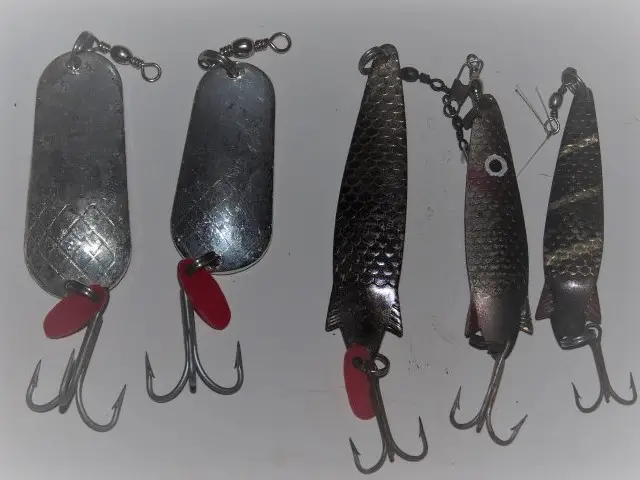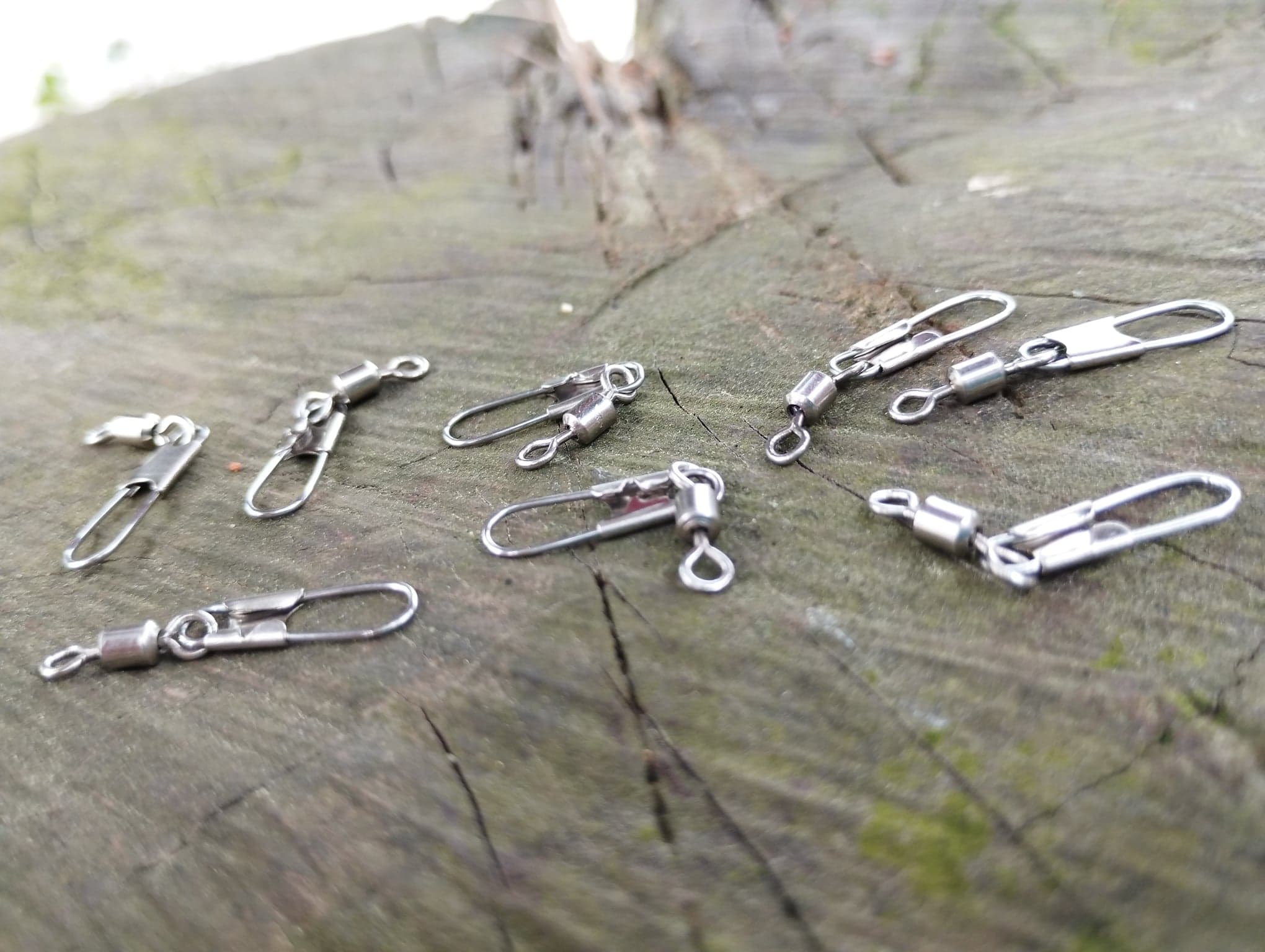For such a tiny piece of metal, swivels generate a lot of discussions and controversy among trout fishermen. Some fishermen consider them an essential piece of kit, while others have them nowhere near their rigs.
In this article, I will take a look at both sides of the debate and discuss when it is a good idea to use a swivel, and when is it best to leave them in the bag.
I will also cover the best type and size of swivels to use when trout fishing.
When spinning for trout, using monofilament line I suggest using a #12 snap swivel to assit in preventing line twist. Snap swivels also make changing lures extremely fast.
The reasons why to use a swivel
1) Swivels help to eliminate line twists
There are two main reasons why swivels are used for trout fishing.
The first is that a quality swivel can assist in reducing line twists which can be a serious headache when fishing with monofilament or nylon line.
When a lure is retrieved through the water it spins rapidly around, and this, in turn, forces countless rotations into the fishing line. This twisted fishing line then develops a mind of its own and will often form knots or tangle itself around the rod guides or even the fishing reel itself. Line twist is bad news.
A swivel, when placed between the lure and the mainline absorbs many of the rotations from the spinning lure, preventing them from twisting the line. So an appropriately sized quality swivel, which is not seized will eliminate most line twists.
2) Snap swivels speed up changing lures.
The most commonly used swivel when spinning for trout is the snap swivel. These swivels make changing lures very fast.
The less time spent tieing knots, the more time spent fishing.
Snap swivels are an excellent option for anyone who struggles to tie a knot, whether due to failing eyesight or lack of practice.
The reasons why not to use a swivel
1) They add another point of potential failure
Some fishermen do not like to use swivels because they add another point of potential failure. Poor quality swivels can snap, and sometimes even open by themselves.
2) Swivels add extra weight which can snag the bottom.
A swivel is an extra piece of gear that can snag the bottom or catch weeds. This is really only a concern when fishing over some very foul ground.
3) Swivels might scare trout
Trout have excellent vision, and they are always on the alert for potential danger or anything suspicious. Some fishermen believe that the mere presence of a swivel can be enough to warn a wary trout that something is not right.
Generally speaking, the smaller, and more petite a lure the greater the chance the swivel could stand out and tip the trout off.
4) Swivels can damage rod guides
Some people get a little too enthusiastic when winding in the line which causes the swivel to get pulled through the rod guides. Rod guides are typically made from harden material and are very durable, but repeated rough handling can eventually result in damage. In extreme cases the rod tip can even be damaged.

Frequently Asked Questions
How to select the best swivel for trout fishing.
Not all swivels are created equal, they are mass produced items and many are poorly made and will be reluctant to spin. A swivel that does not spin belongs in the bin.
Before I use a swivel, I always give them a quick test to see if they spin freely. It only takes a second and could be the difference between relaxing casting and untangling a massive tangle.
Swivels also vary widely in price. The premium brands are typically much better quality and are less likely to cause problems. But, they are significantly more expensive. To be completely honest, I usually purchase bulk swivels under some generic brand rather than pay a premium for a brand name.
Most generic swivels work just fine, just be prepared to throw the occasional defected one away.
Which size of swivel to use when trout fishing
The best size swivel to use when fishing for trout is #12. This size swivel can be used for both fishing with lures or bait. If for some reason you are fishing heavier line, you might want to consider a #8 or #10 instead.
It is a good idea to match the size of the swivel with the diameter of the line you are fishing. Ideally, the diameter of the swivel eye will be slightly larger than the diameter of the fishing line. This helps prevent the metal eye from slowly cutting through the line.
Type of swivels and which is best
There are several different designs of swivels. The ball bearing swivel are generally the best quality and offers less resistance and startup inertia. They start rotating much sooner than an equivalent-size barrel or traditional swivel.
The downside to the ball bearing swivel is size. They do tend to be slightly larger than the more traditional barrel design. They are also more expensive due to the more complicated construction.
It is also important to decide between a standard swivel and a snap swivel. I use a standard swivel when I am including the swivel as part of a rig, or when joining two sections of line together. Such as between the mainline and the leader.
I use a snap swivel at the end of the line to which I connect my lure or spinner to. Snap swivels are more prone to breakages than standard swivels but they certainly do make changing lures faster.
Best swivel materials for freshwater fishing
The materials that swivels are made out of is not of significant concern when trout fishing. All of the materials are strong, and durable enough when used in a freshwater environment.
Swivels are typically made out of either nickel coated brass, brass or stainless steel.
They all work fine when trout fishing, but the nickel coated brass is generally the best option when trout fishing for the following reasons.
- Excellent strength-to-weight ratio
- Value for money.
- Nickel coating also assists in corrosion prevention.
- Nickle coating is quite a dull color so should be less visible to the fish compared with a shiny stainless.
Stainless steel swivels, while stronger also tend to be a bit heavier so are best suited for large saltwater pelagic or sharks.
Do I need to use a swivel when fishing with braid?
Braid does not develop line twist memory anywhere near as badly as monofilament so swivels are rarely required when fishing with braid.
I frequently fish with braid and I never use a swivel. I simply attach the a leader to the braid by using an Aussie Simple knot or Bristol knot. A well tied joining knot is just as reliable as any swivel.
Do I need a swivel when fly fishing?
Swivels serve no purpose when fly fishing. Never use one. If you want to attach a dropper, use a micro ring instead because they are much lighter and more streamlined.
Do I need to use a swivel when fishing with Jerkbaits
Jerkbaits such as Rapalas mostly wobble from side to side rather than spin through the water. They create very little twist so in most cases a swivel is not really required.
Some fishermen, do choose to use a snap swivel because they believe it enhances the movement of the Rapala as it swims from side to side. I have personally caught plenty of fish on jerkbaits without a swivel so do not consider them at all necessary.
Do I need to use a swivel with an inline spinner?
In theory, the blade should spin around the metal shaft. But, more commonly in practice, I find the entire lure starts to spin which can cause a lot of line twists.
When fishing inline spinners, I always use a swivel because they spin through the water a lot and create a lot of twists.
Do I need to use a swivel with a spoon?
It really depends on the spoon, and how much they wobble side to side compared with spinning through the water. I typically do use a swivel when fishing with a spoon on a monofilament line.
I generally do use a snap swivel when fishing with spoons. Simply because I often allow the spoons to drift downstream, and because I am fishing with slack line any line twists can quickly develop into a mess.
So I do recommend using swivels when spinning with a spoon.
It is also a good idea to use a swivel when trolling a spoon behind a boat. When trolling the spoon has plenty of time to create twists in the line.

